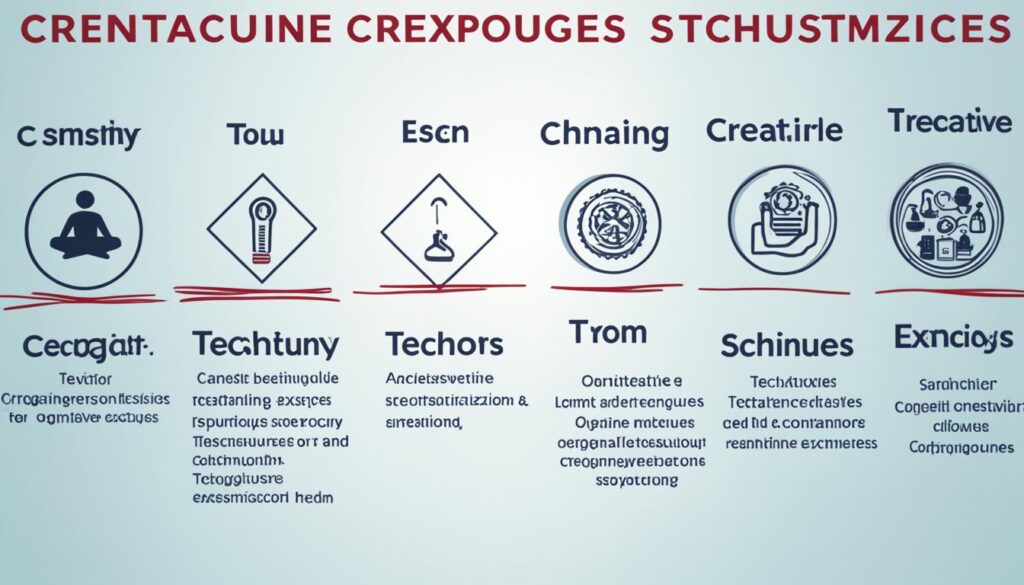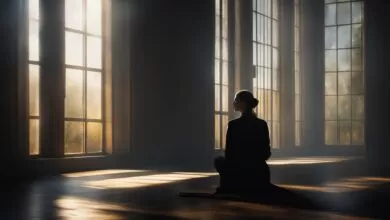Exposure Therapy: Overcoming Anxiety & Fear

Do you think facing your fears can help beat anxiety? Indeed, that’s how exposure therapy works. It’s a type of cognitive-behavioral therapy that guides you to confront what scares you. This includes fears of various kinds, like phobias or panic attacks. Through exposure therapy, you learn how to step into your fears and overcome them.
Now, let’s dive deeper into exposure therapy. We’ll look at how it works, its different forms. Also, we’ll see how it’s making a difference in mental health and happiness.
What Is Exposure Therapy?
Exposure therapy helps people face their fears by bringing them into contact with what they’re afraid of. It’s done in a safe setting to help reduce fear. This way, it aims to make people less likely to run away from what they fear. When left unchecked, this kind of avoidance can actually make the fear stronger over time.
This treatment involves a trained psychologist. They make sure the environment is safe for the person receiving therapy to gradually face what scares them. The goal is to make the person less afraid and to stop avoiding the things that scare them. By doing this, people learn how to face their fears even after their therapy is done, which can lead to lasting improvement.
A psychologist and their client work together to make a plan tailored to the person’s fears. Maybe they’ll start by facing easier fears and move on to harder ones over time. This step-by-step process is all about building up a person’s ability to deal with what scares them.
Exposure therapy is a step-by-step way to deal with fears and avoidances. It lets people face their fears in a way that’s safe and under control. This can help them live a life not dictated by anxiety.
Exposure therapy isn’t just for simple fears like spiders or heights. It also works for anxiety disorders like social anxiety or PTSD. By facing what scares them, people learn they can deal with their fears. This is a big step in managing anxiety and fear disorders.
The key to exposure therapy’s success is in how it’s done gradually. People work through a fear list, starting with small challenges and moving up. With each step, they build the confidence and skills needed to face their fears head-on.
Variations of Exposure Therapy
Exposure therapy comes in different forms to suit each person’s needs. These types help people address and beat anxiety and fear. Here we’ll discuss the main ones:
In Vivo Exposure
This method means facing your fears in the real world. By tackling fears head-on, people get stronger and avoid less.
Imaginal Exposure
Imagining your fears helps you deal with them. This way, you can face and understand your fears in a safe way.
Virtual Reality Exposure
If facing fears in real life isn’t possible, there’s virtual reality. It creates scenarios where you can safely experience and conquer your fears.
Interoceptive Exposure
This type makes you confront physical sensations that scare you but are safe. Overcoming these fears helps you take control and avoid less.
Graded Exposure
Graded exposure starts with small challenges and works up to big ones. It lets you grow step by step, gaining confidence along the way.
Flooding
Flooding dives straight into the hardest tasks first. This way, facing the toughest fears helps people learn to overcome them quickly.
Systematic Desensitization
This combines getting used to fears with relaxation. You learn to connect your fears with being calm. This helps you get more at ease when dealing with what scares you.
Each type of exposure therapy is designed for different needs. The goal is to help people face their fears, stop avoiding, and take back control of their lives.
How Exposure Therapy Works
Exposure therapy is a powerful way to treat psychological issues. It works through key methods like getting used to your fears, learning they’re not so bad, boosting your confidence, and dealing with your feelings.
Promoting Habituation
In exposure therapy, getting used to fears is key. People face their scary things over and over. This makes them less scared. So, by facing fears, they build up strength and make the scary stuff less, well, scary.
Weakening Learned Associations through Extinction
Another part of exposure therapy is extinction. This means breaking old ties between what scares us and bad outcomes. By facing fears safely, the brain learns fears aren’t real threats. Then, old bad thoughts are replaced by new, more real ones.
Promoting Self-Efficacy
Exposure helps us feel we can handle our fears. By facing them step by step, we get better and believe in ourselves. This makes us stronger to deal with scary stuff in the future.
Facilitating Emotional Processing
Dealing with emotions is a big deal in exposure therapy. It lets us really look at what scares us. By doing this, we can change wrong bad thoughts with real facts. This way, we feel less scared and more in control.
Exposure therapy gives us ways to beat our fears. It makes us ready to meet tough times without as much fear.
Exposure Therapy for Phobias
Exposure therapy treats phobias by reducing fear. It helps people beat their anxieties. One method in this therapy, called systematic desensitization, is very good for treating phobias.
In this process, the therapist and client make a fear list together. They list fears from least scary to the most. This ranking helps set up the steps to tackle their fears.
The client then faces each fear step by step. They start by just imagining their fear in a safe place. Then, they move on to facing it in real life.
This method slowly lowers their fear levels. It helps them take back control of their lives. They learn to face their fears and stop avoiding them.
“Exposure therapy is key for overcoming phobias and living well again. It guides people to slowly lower their fears. This builds their strength and courage.”
– Dr. Jane Miller, Phobia Specialist
Through exposure therapy, individuals can beat their fears. The desensitization process helps them slowly face what scares them. This builds their confidence and makes once-scary things manageable.

Exposure Therapy for Posttraumatic Stress Disorder
Posttraumatic stress disorder (PTSD) is a serious problem that can change someone’s life. Exposure therapy is proving to be a helpful way to treat it. In this therapy, people face their fears gradually in a safe space. This helps them handle their PTSD symptoms better.
Virtual reality exposure therapy is a step ahead in this field. It lets people dive into a world that feels just like their scary pasts. With this method, they can find courage to deal with their pasts step by step.
Virtual reality exposure therapy provides a unique opportunity for individuals to work with their triggers that cause severe anxiety. By simulating the traumatic situations, individuals can confront their fears in a safe and controlled environment, allowing for gradual exposure and the development of adaptive coping strategies.
This tech is especially good for veterans. They might get scared by stuff like loud sounds or seeing war zones. With virtual reality, therapy becomes more lifelike but still safe. It helps lessen the bad effects of these memories.
Thanks to exposure therapy, those with PTSD can see their past differently. They start to handle things that used to make them really scared. Therapists who know about this method can be a big help. Together, they make a plan to fight PTSD and make life better.
Exposure Therapy for Social Anxiety Disorder
Social anxiety disorder can really affect how someone enjoys life. It makes simple things, like talking to others, very hard. Luckily, exposure therapy works well against it. This type of therapy helps people face their fears and get better at social situations.
In this kind of therapy, doing real-life things is key. This means slowly facing the things that scare you with the help of a therapist. It breaks the habit of avoiding what makes you anxious.
Clients might start by joining social gatherings or speaking in public. They slowly work up to doing these things by themselves. Doing this in a guided way lets people with social anxiety disorder learn how to manage their fears step by step.
“Exposure therapy for social anxiety disorder helps individuals overcome their fears, reduce avoidance, and improve their ability to navigate social situations.”
This method helps people change how they see social events. It teaches them to worry less and believe in themselves more. Over time, they learn to bounce back from their anxiety and function better at social events.
Overall, exposure therapy is a strong choice for those fighting social anxiety. It helps them get better and feel happier. By facing their fears, people can really change their lives for the better.
Benefits of Exposure Therapy for Social Anxiety Disorder
- Gradual exposure to feared social situations
- Opportunity to confront and challenge negative thoughts and beliefs
- Supportive guidance from a trained therapist
- Improved self-confidence and social skills
- Reduced avoidance behaviors
Exposure Therapy for Panic Disorder
People with panic disorder often feel very anxious and scared. They might have dizziness, chest pain, or fast heartbeats. Interoceptive exposure therapy is a great way to help them. It lets them face their fears in a safe place.
This type of therapy includes making them feel the physical symptoms they fear. But they learn it’s not harmful in a supported setting. By doing this over and over, they realize these feelings are not dangerous.
The aim is to meet these fears and slowly get used to them. In a safe place with therapy, they see how their bodies really react. This helps them understand they are not in danger.
Using this therapy changes lives. It gives people the power to deal with their fears. They can then stop panic attacks and live more freely. It’s a structured way out of the fear cycle.
But, a professional therapist must guide this therapy. They adjust it for each person and keep it safe.
This therapy helps people beat panic disorder. They learn to face fears and symptoms slowly. Then they know how to handle and avoid panic attacks.
Exposure Therapy for Obsessive-Compulsive Disorder
Exposure therapy, or ERP, is a top treatment for OCD. It deals with obsessions and compulsions. Obsessions are unwanted thoughts. Compulsions are the actions people take to feel better.
In this therapy, people face their fears slowly. This happens in a safe place. They do this without doing their usual actions.
Over time, they get less anxious and feel more in control. ERP is customized for each person’s fears. This is key for its success.
For instance, if someone fears dirt, they might touch it without washing their hands. This move helps break the cycle of fear and action. It lowers their overall anxiety.
ERP is proven to work well against OCD. It greatly improves how a person functions. Many experts suggest it as the first choice of treatment for OCD.
The Role of Exposure and Response Prevention in OCD Treatment
“ERP is the best treatment for OCD. It lets people face their fears directly,” says Dr. Elizabeth Evans. She is well-known for treating OCD.
“In exposure therapy, people learn to deal with fear differently. They stop their old habits with the help of therapists. This helps them live better,” Dr. Evans explains.
ERP can also change the brain and improve life in the long run. But, doing it with a specialist is crucial. They make sure it brings positive results safely.
This therapy can help those with OCD feel free from their fears. They can take back control of their lives.
Other Applications of Exposure Therapy
Exposure therapy isn’t just for certain anxieties. It’s useful for many types. This includes things like being afraid to speak in front of people, being worried about driving, or kids who have a hard time being away from their parents. Studies show it can work really well for these issues.
For people with general anxiety, it offers a path to face their fears. They tackle unreasonable worries step by step. And as they face their fears, they take back control of their thoughts and feelings.
Driving anxiety can keep you from being independent. Exposure therapy can help by gradually putting you in the driver’s seat. This way, you can tackle your fears head on and become less afraid of driving.
Many of us are scared to speak in public, be it at school or work. With exposure therapy, you start speaking in front of small groups. Over time, this makes you more confident and less anxious about speaking up in public.
Kids with separation anxiety find it hard to be away from their family. Exposure therapy for them means safely facing these situations. It helps them get used to being apart from their loved ones and teaches them to manage their fears.
In short, exposure therapy is proving to be a great solution for many anxiety issues. It’s helping people face their fears, leading to less anxiety and a better life.
Considerations for Exposure Therapy
Exposure therapy helps people with anxiety disorders. It’s important to look at all the treatment choices. Also, see how it works with other help, like therapy or medicine.
Exposure therapy is done by experts. These could be psychiatrists, psychologists, or therapists. They know how to guide people through facing their fears and give them support.
This therapy can stand on its own for anxiety disorders. It works by slowly exposing people to what they fear. In a safe environment, they learn how to handle their anxiety and stop avoiding things.

It’s also good to mix this therapy with other types. For instance, cognitive therapy can help change negative thoughts. Adding relaxation methods can help calm anxiety while facing fears.
Medicine might be needed for some people during exposure therapy. It helps if someone has really bad anxiety or other medical issues. The medicine can lower anxiety so they can benefit more from therapy.
Finding the right therapist is key for exposure therapy success. They will create a plan just for you. This ensures the therapy is done the right way, helping you get better.
Conclusion
Exposure therapy is a great way to treat different anxiety issues. It helps a lot of people feel less anxious and live better lives. This kind of therapy works well whether it’s the main treatment or used with something else.
It’s key to have a good therapist for this kind of treatment. They should know how to adjust the therapy to fit you. They will help keep you safe and support you through it.
Exposure therapy involves facing your fears a little at a time, in a safe space. This method can beat anxiety and fears for good, leading to better mental health. If you’re looking to get rid of anxiety, think about trying exposure therapy. It could make a big difference in your life.






